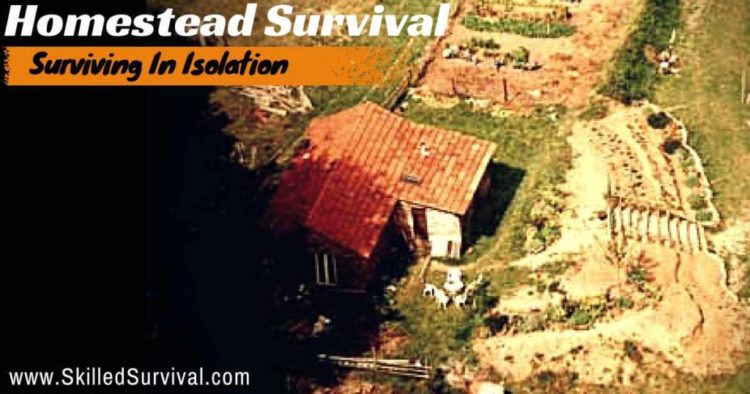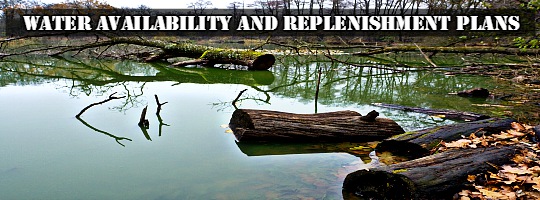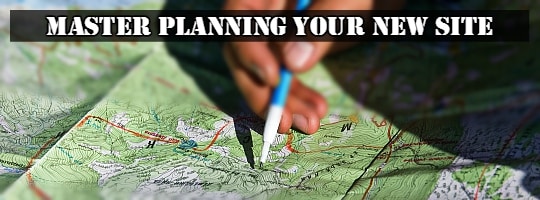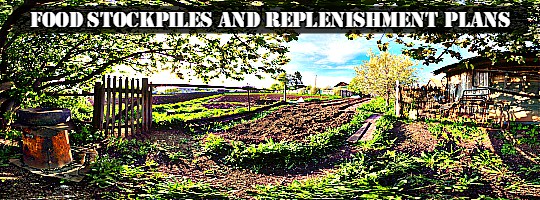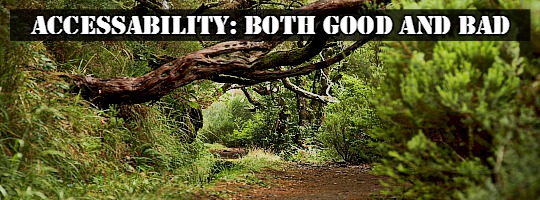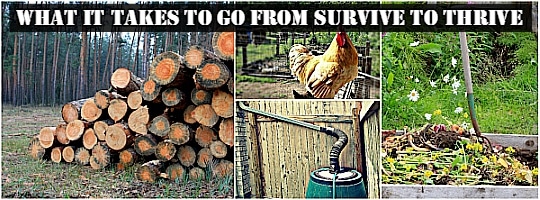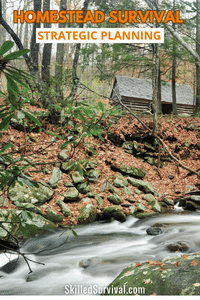 Today, I’ve got something really important to share…
Today, I’ve got something really important to share…
A Complete Guide On Planning & Building A Homestead For Survival
Because once you’ve got a bug-out location, you need to figure out how to establish it.
That’s where homestead and survival come together.
You need to devise a plan to develop your property into an SHTF safe haven.
A self-reliant homestead survival home where you can thrive.
TOPICS IN THIS GUIDE… ↓(click to jump)
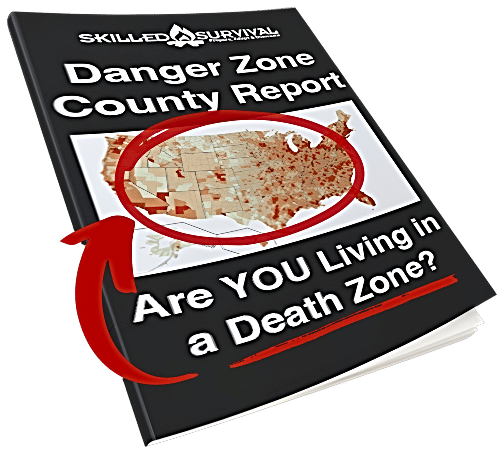
Click here to download this report and see if you’re in a Danger Zone County (or not). No purchase necessary.
↓ Building a Homestead in 100 Days – Day 1
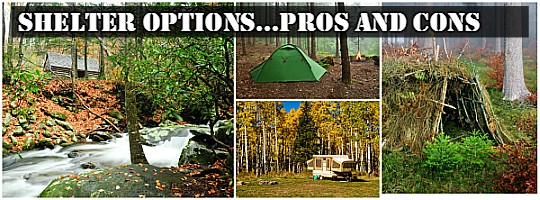
1. Decide What Sort Of Roof You Want Over Your Head
The best shelter for your bug-out property depends on whether it’s private or public land.
Also, financial resources (as always) will come into play.
Maybe you purchased a homestead with a small survival cabin already on it.
That makes this section simple; you can move on to the next section of this article.
However, you can decide what works best if you have a blank slate or plan to squat on public land.
If you have private land, then you have all the options available.
- Build a bug-out cabin
- Park an RV or use any number of camper setups
- Or keep it basic and go with a tent
I prefer the first two options, a home or a cabin, but it’s your land, so you decide.
Building a home or cabin ahead of time is unrealistic if you plan to haul ass out to a remote piece of public land.
Laws become the problem; you don’t own them, so you can’t build on them.
If you have skills and tools, you can build a simple cabin after SHTF (when laws no longer matter).
But this won’t be possible ahead of time.
So you must plan on an RV, camper, or tent.
These are mobile shelters, and being mobile can be a plus.
But it makes it harder to move your homestead survival supplies ahead of time.
There are two categories of shelter options: mobile shelters and non-mobile shelters.
Homes, bunkers, and cabins are non-mobile options.
↓ Building My BEST DUGOUT EVER – ALONE into Wild Forest
They are great if you do not intend to move, but you can build them before SHTF.
If your non-mobile bug-out location gets attacked, you’ll want to defend it by any means necessary.
The good news is, if you stock this shelter with lots of guns, ammo, food, water, etc., you’ll be ready.
You can also set up your property with alarm systems and booby traps.
Now, you will be a tough target for any unfriendly strangers.
RVs, campers, and tents are the primary mobile options.
If things go south and the conditions change, you can leave.
You can look for a new location to set up shop.
The downside is that it’s much harder to stockpile key supplies such as guns, ammo, food, etc.
You can do it; it’s just much harder to do.
Your stock limit will be what you can haul in your bug-out vehicle.
You can stock RVs and campers.
But it will be harder to find remote concealed places to park these (especially if they are large).
If they are small, they won’t stock as much food or gear.
There are always those damn tradeoffs in survival.
If you plan to set up a tent, you will carry your supplies to live heavily off the land.
In this case, you’ll need to make several trips to leave many cached resources each time you visit.
If you plan to do this, you can buy some plastic barrels with good seals and bury them in the ground, waiting for SHTF.
So your choice of bug-out shelter is drastically dependent.
It depends on how you plan to bug out and your resources.
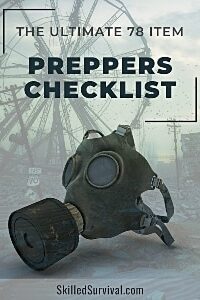
Click here to instantly download this Complete Checklist PDF. No purchase necessary.
2. Quench Your Thirst With Less Effort
I’m going to assume that you found a property with plentiful water.
One with a natural water source nearby (per my essential quality #2 on finding a good bug-out location).
Whether it’s a lake, pond, river, or creek does not matter.
Otherwise, you’ll need to put a lot of thought and effort into your water storage system.
An extensive water storage system is unnecessary if you live near the water source.
Caution: The closer you are to the water source, the higher the chances of flooding, so be aware.
You’ll also want a water storage system if your shelter is not close to your water source.
A system that you can occasionally fill up and be good on water for a few days.
Batching your water-gathering efforts is an important time-saving survival efficiency.
You’ll also want to consider a rain collection system.
↓ Easy DIY Rain Water Catchment System
You can never really have too much water stored.
You’ll collect fresh water in barrels by setting up a rainwater collection system.
You can locate your barrels inside or just outside your shelter if done right.
Making rainwater use efficient.
You can even do this without a traditional roof.
You need to use tarps.
↓ Rain Collection – Quick Deploying Rain Catchment
3. Your Layout Matters A Lot, So Get It Right The First Time
So far, we’ve covered your shelter options and discussed your water resources.
Now, it’s time to figure out the best place to set up your shelter.
The final location is less critical if your shelter is mobile (tents, campers, RV’s).
Why? Because you can move it at any time.
Yet, if your plan includes a home, cabin, or bunker, you must think it through carefully.
Before building your shelter, you’ll want to create a master site plan for your land.
What’s a “master site plan”?
Well, it’s a plan to help you think about how to use your land.
It should help you decide the best spot for your shelter.
Here are a few things you need to consider…
- Where is the best setup for your base camp from a concealment and defense standpoint?
- How close can you set up your shelter to your water resource?
- Where’s the best place for an extensive garden?
These answers vary depending on the property you are working with (private or public).
Yet, I will suggest the following for most homestead survivalists:
Locate your shelter as close to your water source as possible without putting it at high risk of flooding.
An exception to this is if that area jeopardizes your concealment efforts.
If the water on your property is right next to a gravel road, keep your shelter as far away from the road as possible, even if it moves it further away from the water.
The reason it’s best to stay close to your water source because hauling water is an absolute chore.
It’s a chore you’ll often do (unless you’ve invested in a solar water pump).
The closer you are to the water source, the easier this task will be.
You’ll also want to try to locate your garden as close to the water source as possible.
Assume you’ll need to water your
But you can’t expect a
So, if getting good sun is an issue, you can strategically remove a few trees.
This will help your
You can also chop up these trees for firewood.
There’s a lot to think about here, but this is how I would rank all these factors:
1. Concealment
If you can avoid unwanted attention, then you’ll be less likely to have to defend your property.
Not being near your water source might be a major inconvenience, but fighting off bandits every other day would be much worse.
Often, the best place for concealment will be farthest from the easiest access point.
- If there is an entrance road, you’ll want to locate your shelter as far back on the property as possible.
- If there is no entrance road, try to figure out which direction people would access your property.
Then, establish your shelter as far away from that entrance as possible.
If you do this right, you can install basic alarm systems.
These will sound anytime someone enters your property.
Just be aware that wildlife will also trip these alarms.
↓ 12 Gauge Booby Trap Trip Wire Alarm Review
2. Distance
Your second priority is shelter distance from your water source.
Ideally, concealment and your water resource location are complementary to each other.
You have a great setup if the concealment is good next to the water source.
If not, I suggest you choose better concealment over the hassle of hauling water.
3. Garden Setup
Your third priority is the setup of your garden.
You want to locate your
It’s also preferable to locate your
Ideally, that would also be close to your shelter.
Those are the 3 major considerations when trying to master plan your survival homestead.
You’ll discover that putting some upfront thought into it will provide value later.
↓ 5 Cheap DIY Home Garden Tips to Grow Your Own Vegetables

Click here to instantly download this Complete Checklist PDF. No purchase necessary.
4. Your Survival Will Eventually Come Down To Food; Plan For It
This might be the most difficult part of your homestead survival plan.
Why? Because the skills you need to do this properly are vast.
Many of us (myself included) don’t rely solely on modern-day food systems to sustain our families.
Our current calorie intakes are dependent on the “food system.”
The massive food system works today, but what happens when it fails?
Most of us are nearly 100% dependent upon this food system.
A Quick Breakdown Of Our Modern Food System
Farmers generally depend on seed producers, equipment makers, fertilizers, and pesticides.
These are all necessary to produce high yields per acre.
Food manufacturers depend on farmers, equipment manufacturers, electricity, trucking companies, and labor workers.
If any of these items become compromised, so does a food manufacturer’s production ability.
At least at the current production levels, they produce today.
The grocery stores depend on farmers, food manufacturers, and trucking companies.
And we are dependent on this entire system.
↓ You’re At The Mercy Of The Food Supply Chain (Like It Or Not)
Sure, some of us have gardens, some larger than others.
But does this garden alone feed you daily? No.
Many of us hunt and even freeze excess meat for future use.
But do you hunt enough meat to feed you daily? No.
Even if you did hunt enough, do you practice the skills of preserving this meat without a freezer?
Do you have a smokehouse and a root cellar?
Do you package your meat with copious amounts of salt and check it regularly for signs of spoilage?
The odds are no.
Do you forage your local area for fruits and berries?
Is there enough to provide a significant percentage of your family’s calorie needs?
Doubtful.
This is why I say,
“Food replenishment is the most challenging part of your long-term bug out plan.”
Those in the pre-technological age (think 1850 frontier homesteads) had poor survival rates.
Especially when compared to today’s standards. Yet, they lived and breathed these survival skills DAILY.
Every winter, they faced the real possibility of starvation.
Not to mention the challenges of illnesses, freezing, animal attacks, and Indian attacks.
An SHTF future will look a lot like the past, and people of the 1800s were expert survivalists.
So what chance does the modern-day American have when thrust into this dire situation?
Ok, you get it. It won’t be easy.
Now that that’s out of the way, here’s what I recommend you do to prepare for this dire situation.
I believe in a four-pronged approach to this problem.
1. Build a large food stockpile as an insurance policy.
The bigger your food stockpile today, the more time you have to establish your food system.
Let’s say you stockpiled three years’ worth of 25-year shelf-life food.
You now have three years to “figure it out.”
Expand your independent food system when grocery shopping is no longer an option.
You have three years to figure it out.
Growing your
You should practice these skills today to help give yourself a nice head start.
So when SHTF and life as we know it is over, your new job is to become a full-time homesteading survival expert.
If you have only six months of food stockpiled, you will only have six months to figure it out.
It’s better than nothing, but I like my three-year odds better.
The bottom line:
Stockpile as much food as you can ahead of time.
Sure, it may run out eventually, but you’re buying precious time to figure out your skills.
2. Practice your homestead survival skills on a smaller scale today.
You don’t need to live independently of the food system yet.
For most of us, it would be nearly impossible to do so anyway and still live a normal existence today.
You probably have a full-time job, and maybe you have kids.
How in the world can you find the time to live off only the food you produce?
The answer is you probably can’t.
So, instead, hone all these skills in smaller doses.
Grow a backyard garden.
Tend to it regularly and practice growing different fruits and vegetables each season.
Buy heirloom seeds and then practice seed saving.
Seed saving will help you become independent when buying new seeds each season.
Start a compost pile and learn how to tend it properly.
It’s not nearly as hard as you think and worth it.
Go hunting when hunting seasons are open for small game, large game, and birds.
Then, take a percentage of the meat and practice making jerky.
Package it in salt to see how long you can keep it before it spoils.
Start canning it.
Forage for fruits, berries, and plants in your local areas.
Teach your kids how to identify them and learn what’s edible and what’s not.
Learn about edible plants and how to cook them.
Add them to your meals occasionally.
Identify poisonous plants and become experts at identifying edible vs. deadly plants.
Raise backyard chickens for eggs and meat.
Build a backyard aquaponics system for fish and veggies.
Try your hand at beekeeping by building a backyard apiary.
If you have your bug-out location sorted out, start planting longer-term items, such as fruit trees on the land.
Perfect these skills a little bit at a time each day.
These skills will be a major shortcut in the future when your life depends upon them.
3. Take advantage of the internet while you still can.
The majority of people who use the internet today are wasting their time and wasting their potential.
Cute cat videos, who gives a crap “status” updates, and filthy adult site surfing are popular internet activities today.
And this is a huge waste of potential.
You are different.
You are using the internet to better yourself.
Think of the Internet as the largest knowledge library ever assembled.
This library has a lot of trash, but it also has unimaginable useful knowledge.
When you stop to think about it, it’s the one advantage we have versus those living in the 1800s.
They learned through trial and error, word of mouth, dumb luck, or (for the few lucky ones) a book or two.
You use the internet and can tap into all the available knowledge about homesteading survival.
This advantage can speed up your survival and prepping skills tenfold.
You do this by visiting the right sites and following the right methods.
You must assume that the Internet will no longer be available after SHTF.
- So, find these sites today.
- Subscribe to their email lists.
- Download, print, and practice all the skills they offer.
The internet is your secret weapon; don’t waste it.

Click here to instantly download this Complete Checklist PDF. No purchase necessary.
4. Create or join a survival coalition you can trust.
To be blunt, trying to survive SHTF alone (a single person or small family) will be near impossible.
You need to be able to do some basic bartering and have a support community.
You don’t necessarily have to live right next to this group.
But you still need a barter system to access basic supplies in the future.
Salt is critical for meat preservation without electricity.
Unless you live near the ocean, the only way to continue getting salt is to find others with access to it.
Medical supplies, same deal.
You should begin stockpiling key medical supplies today.
Why? Because at some point, you will run out.
That’s when you’ll rely on your barter systems to access these critical items.
Coalitions are also great for going on supply runs.
A group heading to an abandoned town to find supplies is safer than an individual.
The key is to join a group you can trust with your life.
When things get bad, you need to know the group is like-minded and will work together as a team.
You have two options.
You can either find a like-minded survival coalition and try to join them.
Or, start a survival coalition.
Or join my online coalition called TheResilientLife.
Following these four steps will significantly improve your odds of keeping your family fed no matter what happens.
5. How’s Your Accessibility? The Double-Edged Sword
Is your choice of bug-out location relatively easy to access?
If you answered yes, that’s great; you’ll have no problems getting to your bug-out property fast with many supplies and gear.
You’ll be able to easily leave your establishment to go on supply runs and come back quickly.
The bad news?
Strangers can drive up to your bug-out encampment with ease.
They WON’T be of the friendly variety after SHTF!
If you answered no, then that’s great.
The odds of bandits stumbling upon your encampment will be significantly reduced.
The bad news? It’s going to suck getting established.
You might have to haul all your supplies on foot, probably by backpack.
Supply runs might take days to accomplish.
So there it is – the double-edged sword.
The benefits and risks of accessibility.
Hopefully, you can find ways to do both.
Maybe you can conceal your access entrance with natural debris.
Overgrown bushes or downed logs can help significantly.
Moving this debris whenever you want to enter and leave might be a hassle.
But it might be well worth the effort to keep your property hidden.
Again, alarm systems and booby traps can help deter strangers from seeking out your establishment.
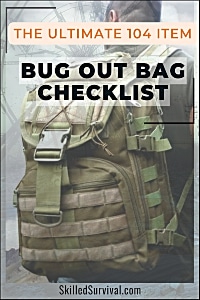
Click here to instantly download this Complete Checklist PDF. No purchase necessary.
6. What It Takes To Go From Survive To Thrive
So, what are some of the luxuries of setting up a thriving bug-out location?
Here are some items that can develop a basic bug-out establishment.
To help turn it into a thriving survival homestead.
Unfortunately, each one of these homesteading skills deserves its own blog post.
Overwhelming? That Means You Better Get Started
For many of you, all these steps might seem overwhelming because it won’t be easy.
To survive the worst-case TEOTWAWKI, you need to roll up your sleeves and begin planning and doing.
↓ America’s Biggest Threats In 2023+


Homestead Action Plan
Here is your action plan:
- Determine where you are going to bug out to Private or Public land.
- Decide on your homestead survival shelter options and build or buy what you can afford. Maybe you want to build a cabin, but have a camper for now (just in case) until that dream becomes a reality. Great. Always have your plans and goals and you’re “if today’s the day” plan.
- Decide how elaborate you want your bug-out homestead to be—water resources, food supplies, firewood, gear, etc. Start purchasing an item or two a month.
You can start small.
Buy a month’s worth of long-shelf-life food and some seeds.
If you’re nowhere near ready, you must think both short-term and long-term.
Start Small and Build From There
In the short term, what do you have to work with already?
What food, gear, supplies, and skills do you have, and are they enough?
What food, gear, supplies, or skills do you need to get you to a bare minimum of being prepared?
Decide the bare minimum for you, and then start building up to that as quickly as possible.
Once you’ve achieved that basic level of preparedness, what’s next?
How can you move from the bare minimum to something better?
- Maybe you need an upgraded shelter. You could get that cabin built or buy a larger RV.
- Perhaps you can afford a solar oven and start practicing a few meals.
- Maybe you can find a solar panel or two on Craigslist for cheap.
What about practicing setting up a basic perimeter alarm system in your current backyard?
Or how about stocking a few items for future bartering purposes?
The key is to get to the bare minimum level of preparedness as soon as possible.
The potential for a life-altering disaster is too great; it’s time to get serious.
Then, once you meet that minimum level of preparedness, it’s time to keep going.
It is time to grow your abilities and supplies to a level we all recognize as thriving.
Remember:
A journey of a thousand miles starts with a single step.
Why Trust Skilled Survival…
Go here now to review a full breakdown of:
- Who We Are
- Our Credentials
- Our Mission
- & Product Recommendations…
Here are a few highlights of our teams credentials & certifications:
- Certified Member of a Mountain Search & Rescue Organization
- Plant Emergency & Safety Leader for a Major Food Manufacturer
- Member of the 10TH Mountain Division Hut Association
- Certifications: Avalanche 1, WFR, CPR
- Official Gear Tester for Numerous Outdoor Gear Companies
- Countless Multiday Backpacking trips into Remote Wilderness
- Bachelor’s Degree In Mechanical Engineering
- Bachelor’s Degree In Civil Engineering
- Bachelor’s Degree In Biomedical Engineering
“It takes 20 years to build a reputation and five minutes to ruin it.” – Warren Buffett
We’re fully aware that trust is NOT something you GET but is EARNED.
And we’ll continue to earn YOUR trust through our forthright and honest approach with each new Blog Post, Guide & Product we create…
Prepare, Adapt & Overcome,

Find out now using my Danger Zone County List & Special Report it’s absolutely FREE.
In minutes you’ll know EXACTLY where you stand and if you should be worried or not..
So click here to get my FREE Danger Zone County List & Report…


Get My 10 Steps To Basic Preparedness Video For FREE.
Plus daily survival tips (unsubscribe anytime).
Recommended Reading
Read the full article here

